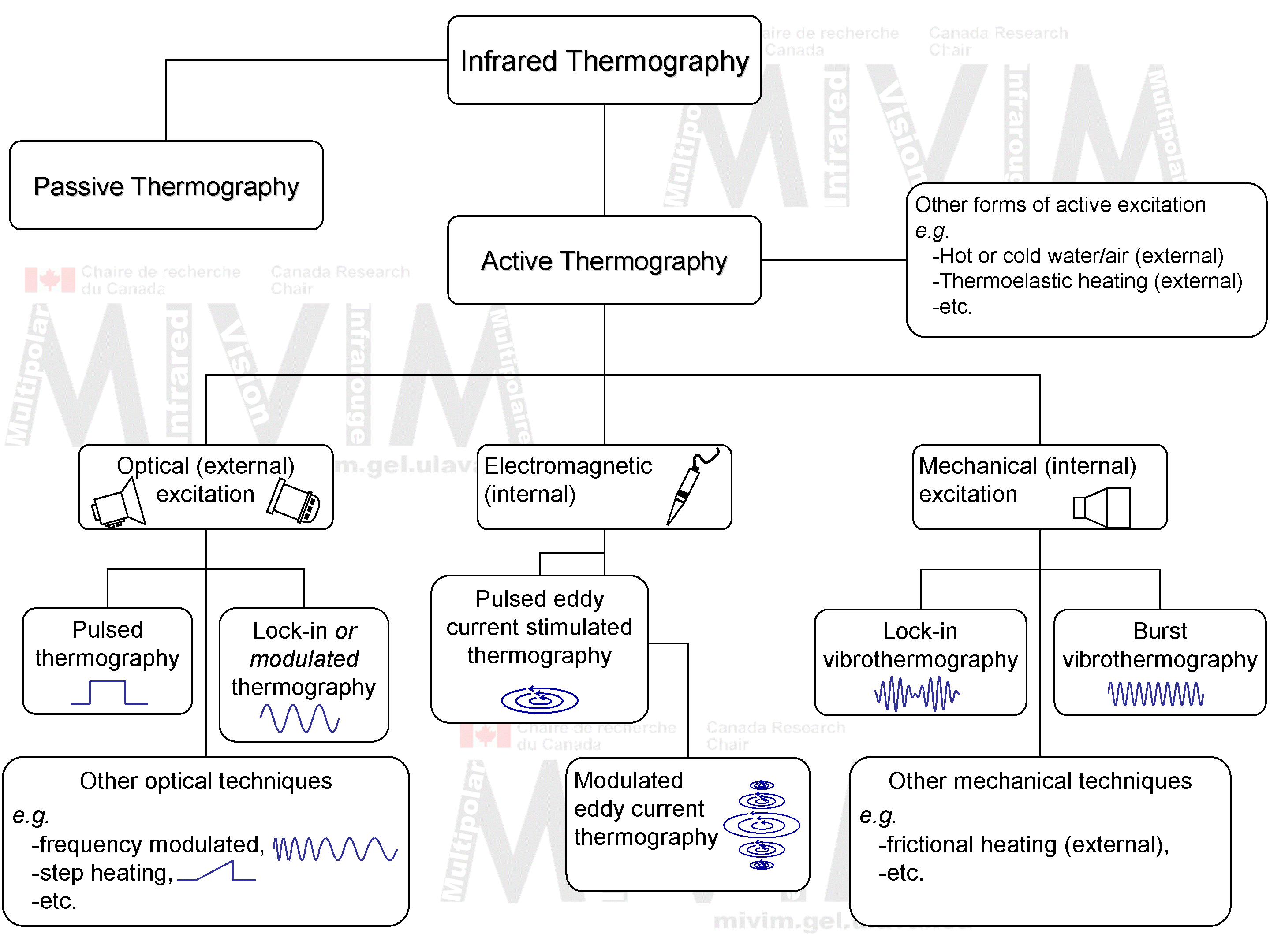
Thermographic inspection
Encyclopedia
Thermographic inspection refers to the nondestructive testing
of parts, materials or systems through the imaging of the thermal patterns at the object's surface. Strictly speaking, the term thermography alone, refers to all thermographic inspection techniques regardless of the physical phenomena used to monitor the thermal changes. For instance, the application of a temperature sensitive coating to a surface in order to measure its temperature is a thermographic inspection contact technique based on heat conduction where there is no infrared sensor involved. Infrared thermography on the other hand, is a nondestructive, nonintrusive, noncontact mapping of thermal patterns or "thermograms", on the surface of objects through the use of some kind of infrared detector.
In addition, there are two approaches in thermographic inspection: (1) passive, in which the features of interest are naturally at a higher or lower temperature than the background, for example: the surveillance of people on a scene; and (2) active, in which an energy source is required to produce a thermal contrast between the feature of interest and the background, for example: an aircraft part with internal flaws.
When compared with other classical nondestructive testing
techniques such as ultrasonic testing or radiographic testing
, thermographic inspection is safe, nonintrusive and noncontact, allowing the detection of relatively shallow subsurface defects (a few millimeters in depth) under large surfaces (typically 30x30 cm2 at once, although inspection of larger surfaces is possible) and in a fast manner (from a fraction of a second to a few minutes depending in the configuration, see below).
There are many other terms widely used all referring to infrared thermography, the adoption of one or other term depends on the author’s background and preferences. For instance, Video Thermography and Thermal Imaging draw attention to the fact that a sequence of images is acquired and is possible to see it as a movie. Pulse-Echo Thermography and Thermal Wave Imaging,, are adopted to emphasize the wave nature of heat. Pulsed Video Thermography, Transient Thermography,, and Flash Thermography, are used when the specimen is stimulated using a short energy pulse.
 A wide variety of energy sources can be used to induce a thermal contrast between defective and non-defective zones that can be divided in external, if the energy is delivered to the surface and then propagated through the material until it encounters a flaw; or internal, if the energy is injected into the specimen in order to stimulate exclusively the defects. Typically, external excitation is performed with optical devices such as photographic flashes (for heat pulsed stimulation) or halogen lamps (for periodic heating), whereas internal excitation can be achieved by means of mechanical oscillations, with a sonic or ultrasonic transducer for both burst and amplitude modulated stimulation. As depicted in the figure, there are three classical active thermographic techniques based on these two excitation modes: lock-in (or modulated) thermography and pulsed thermography, which are optical techniques applied externally; and vibrothermography, which uses ultrasonic waves (amplitude modulated or pulses) to excite internal features.
A wide variety of energy sources can be used to induce a thermal contrast between defective and non-defective zones that can be divided in external, if the energy is delivered to the surface and then propagated through the material until it encounters a flaw; or internal, if the energy is injected into the specimen in order to stimulate exclusively the defects. Typically, external excitation is performed with optical devices such as photographic flashes (for heat pulsed stimulation) or halogen lamps (for periodic heating), whereas internal excitation can be achieved by means of mechanical oscillations, with a sonic or ultrasonic transducer for both burst and amplitude modulated stimulation. As depicted in the figure, there are three classical active thermographic techniques based on these two excitation modes: lock-in (or modulated) thermography and pulsed thermography, which are optical techniques applied externally; and vibrothermography, which uses ultrasonic waves (amplitude modulated or pulses) to excite internal features.
YAKA
Nondestructive testing
Nondestructive testing or Non-destructive testing is a wide group of analysis techniques used in science and industry to evaluate the properties of a material, component or system without causing damage....
of parts, materials or systems through the imaging of the thermal patterns at the object's surface. Strictly speaking, the term thermography alone, refers to all thermographic inspection techniques regardless of the physical phenomena used to monitor the thermal changes. For instance, the application of a temperature sensitive coating to a surface in order to measure its temperature is a thermographic inspection contact technique based on heat conduction where there is no infrared sensor involved. Infrared thermography on the other hand, is a nondestructive, nonintrusive, noncontact mapping of thermal patterns or "thermograms", on the surface of objects through the use of some kind of infrared detector.
In addition, there are two approaches in thermographic inspection: (1) passive, in which the features of interest are naturally at a higher or lower temperature than the background, for example: the surveillance of people on a scene; and (2) active, in which an energy source is required to produce a thermal contrast between the feature of interest and the background, for example: an aircraft part with internal flaws.
When compared with other classical nondestructive testing
Nondestructive testing
Nondestructive testing or Non-destructive testing is a wide group of analysis techniques used in science and industry to evaluate the properties of a material, component or system without causing damage....
techniques such as ultrasonic testing or radiographic testing
Radiographic testing
Radiographic Testing , or industrial radiography, is a nondestructive testing method of inspecting materials for hidden flaws by using the ability of short wavelength electromagnetic radiation to penetrate various materials.Either an X-ray machine or a radioactive source can be used as a source...
, thermographic inspection is safe, nonintrusive and noncontact, allowing the detection of relatively shallow subsurface defects (a few millimeters in depth) under large surfaces (typically 30x30 cm2 at once, although inspection of larger surfaces is possible) and in a fast manner (from a fraction of a second to a few minutes depending in the configuration, see below).
There are many other terms widely used all referring to infrared thermography, the adoption of one or other term depends on the author’s background and preferences. For instance, Video Thermography and Thermal Imaging draw attention to the fact that a sequence of images is acquired and is possible to see it as a movie. Pulse-Echo Thermography and Thermal Wave Imaging,, are adopted to emphasize the wave nature of heat. Pulsed Video Thermography, Transient Thermography,, and Flash Thermography, are used when the specimen is stimulated using a short energy pulse.
Techniques

YAKA
See also
- Infrared visionInfrared visionInfrared vision can be defined as the capability of biological or artificial systems to detect infrared radiation. The terms thermal vision and thermal imaging, are also commonly used in this context since infrared emissions from a body are directly related to their temperature: hotter objects...
- Infrared thermography
- Infrared camera
- Infrared detectorInfrared detectorAn infrared detector is a photodetector that reacts to infrared radiation. The two main types of detectors are thermal and photonic.The thermal effects of the incident IR radiation can be followed through many temperature dependent phenomena....

